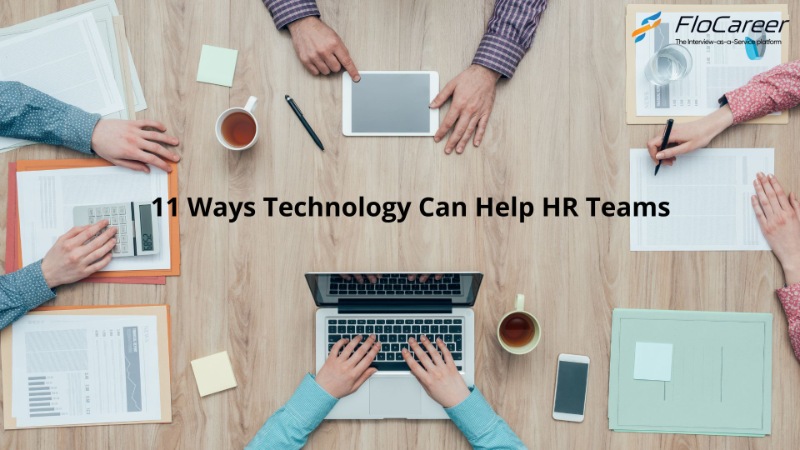11 Ways Technology Can Help HR Teams
In the dynamic landscape of modern business, Human Resources (HR) teams serve as the linchpin for organizational success. Beyond curating a skilled workforce, HR professionals address the myriad needs of employees, fostering satisfaction and engagement. As technology advances, it reshapes HR operations, offering solutions that automate tasks, enhance recruitment processes, and elevate employee engagement.

1. Automation of Administrative Processes
Embracing automation liberates HR teams from the burden of repetitive and time-consuming tasks, fostering increased efficiency and cost savings. Tools such as Gusto and SurePayroll automate payroll and benefit calculations, eliminating manual errors and expediting the process. Solutions like Calamari and AttendoPlus streamline time and attendance record-keeping, while record management tools like Zoho Docs and LogicalDoc ensure transparency and accountability.
2. Revolutionizing the Interviewing/Hiring Process
Efficient hiring processes are paramount for attracting top talent. Streamlining interviews and making unbiased, data-centric decisions can be achieved through innovative platforms like Flocareer. Tips for improvement include recording interviews for seamless collaboration, mitigating interviewer bias with structured interviews, and incorporating AI-powered interviewer training for continuous improvement.
3. Ensuring Compliance with HR Laws
Staying compliant with labor and employment regulations is a non-negotiable responsibility for HR teams. Utilizing compliance software solutions such as Libryo or Donesafe, staying updated on compliance laws through newsletters, and conducting regular HR audits ensures adherence to legal obligations.
Data Privacy Compliance
In an era where data privacy is a paramount concern, HR professionals must ensure compliance with regulations such as GDPR (General Data Protection Regulation) and other regional data protection laws. Implementing robust data protection policies, obtaining explicit consent for data processing, and regularly auditing data handling processes contribute to a compliant and secure HR environment.
Diversity and Inclusion Compliance
Promoting diversity and inclusion is not only a moral imperative but also a legal requirement in many jurisdictions. HR teams should actively work towards compliance with anti-discrimination laws, ensuring fair treatment of employees regardless of race, gender, age, or other protected characteristics. Regular training programs on diversity and inclusion can further reinforce compliance efforts.
Accessibility Compliance
Inclusivity extends to ensuring accessibility for employees with disabilities. HR teams should align with accessibility standards such as the Americans with Disabilities Act (ADA) to accommodate individuals with diverse needs. This involves making workplace technologies, communication channels, and facilities accessible to everyone, fostering an inclusive and compliant workplace.
Social Media Compliance
The pervasive use of social media introduces new challenges for HR professionals. Compliance efforts should extend to social media policies that govern employee behavior online. Establishing clear guidelines on acceptable social media conduct, protecting employee privacy rights, and addressing potential issues arising from social media activities contribute to a compliant HR strategy.
Ongoing Training on Legal Updates
Laws and regulations governing HR practices evolve, requiring continuous adaptation. HR teams should invest in ongoing training programs to keep staff abreast of the latest legal updates. This proactive approach ensures that the organization remains compliant with changing laws, minimizing the risk of legal consequences and maintaining a culture of legal awareness within the HR department.
These additional points extend the scope of HR compliance to encompass emerging concerns such as data privacy, diversity and inclusion, accessibility, social media, and the importance of continuous legal education. Adopting a holistic approach to compliance safeguards the organization against potential legal challenges and promotes a workplace culture that values legal adherence and ethical conduct.
4. Optimization of Employee Onboarding
Creating an effective onboarding process is crucial for integrating new hires successfully. Utilizing tools like Deel, Trakstar, and Wrike streamlines the onboarding process, ensuring a well-organized plan, pre-employment engagement, mentorship programs, and regular progress monitoring for heightened employee satisfaction.
Gamified Onboarding Modules
Introducing gamification elements into the onboarding process can enhance engagement and knowledge retention. Creating interactive and gamified modules can make learning more enjoyable for new hires. Incorporating quizzes, challenges, and rewards within the onboarding platform can transform the process into an interactive experience, fostering a positive and memorable introduction to the company culture.
Personalized Onboarding Journeys
Recognizing that each employee is unique, HR teams can optimize onboarding by tailoring the process to individual needs. Implementing personalized onboarding journeys based on the role, department, or specific employee preferences ensures that new hires receive relevant information. This customization helps employees feel valued and supported from their very first days, contributing to a more positive onboarding experience.
Social Integration Programs
Facilitating social integration is crucial for building strong team dynamics. HR can optimize onboarding by organizing social events, team-building activities, or mentorship programs during the initial weeks. Creating opportunities for new hires to connect with colleagues on a personal level fosters a sense of belonging and accelerates the formation of positive relationships within the workplace.
Continuous Feedback Loops
Establishing continuous feedback mechanisms throughout the onboarding process enables HR to identify and address any challenges faced by new hires promptly. Regular check-ins, surveys, or feedback sessions can provide valuable insights into the effectiveness of the onboarding program. Adjustments can be made in real-time, ensuring a dynamic and responsive onboarding experience that evolves with the changing needs of the employees and the organization.
Integration of Technology for Onboarding Automation
Expanding on the use of technology, HR teams can optimize the onboarding process further by leveraging automation tools. Automated workflows for document submission, task reminders, and progress tracking streamline administrative aspects of onboarding. This not only saves time but also reduces the likelihood of errors, allowing HR professionals to focus on more strategic aspects of the onboarding experience.
Cultural Assimilation Initiatives
Beyond job-related information, effective onboarding should also focus on cultural assimilation. HR can optimize this aspect by incorporating initiatives that showcase the company's values, mission, and workplace culture. This may include storytelling sessions, cultural workshops, or introductions to key cultural elements within the organization. Helping new hires align with the company's ethos from the beginning contributes to long-term employee satisfaction and retention.
Performance Metrics and Analysis
Implementing performance metrics related to onboarding processes allows HR teams to measure the success and efficiency of their onboarding programs. Key performance indicators (KPIs) could include time to productivity, employee engagement levels post-onboarding, and retention rates. Analyzing these metrics provides valuable insights for continuous improvement, helping HR refine onboarding strategies for maximum impact.
These additional points extend the optimization of employee onboarding beyond the initial logistics to encompass personalization, social integration, feedback, technology integration, cultural assimilation, and performance analysis. A comprehensive approach to onboarding contributes to a smoother transition for new hires and sets the stage for long-term success within the organization.
5. Deployment of a Performance Management Solution
Performance management, facilitated by tools like AssessTEAM and Zoho People, enables HR professionals to access real-time performance data. This leads to data-driven insights, time-saving through goal automation, tailored development plans, and regular feedback and coaching for employee satisfaction.
6. Ensuring Security in Hybrid/Remote Work
As remote and hybrid work become prevalent, securing company data is imperative. Encouraging the use of security tools like VPNs, antivirus software, and firewalls safeguards against cyber threats. Educating remote teams on cybersecurity best practices further strengthens the organization's security posture.
7. Harnessing Online Learning and Training Platforms
Online learning platforms like SAP Litmos, Udemy Business, Talent Cards, and Skillable facilitate quick institutionalization of new hires. They offer consistent onboarding experiences, training on specific skills, and self-paced learning, freeing up time for HR professionals.
8. Investment in Employee Self-Service Platforms
Employee self-service platforms like SP Employee Self-Service Portal, SAP SuccessFactors, and BambooHR empower employees to handle HR-related tasks independently. These platforms offer convenience, time-saving, increased accuracy, and improved communication between employees and HR professionals.
Leveraging Technology for Unbiased Interviews with Flocareer
In the realm of interview outsourcing, Flocareer emerges as a game-changer. Outsourcing interviews with Flocareer ensures unbiased, consistent, and fair interview processes through AI-driven tools. This commitment to standardized evaluation criteria aligns with the organization's dedication to diversity and inclusion, ultimately contributing to its success.
9. Enhancing Employee Engagement Through Technology:
Employee engagement is a crucial aspect of HR management, and technology plays a pivotal role in fostering a connected and motivated workforce. Platforms like Slack, Microsoft Teams, or even dedicated employee engagement tools enable seamless communication, collaboration, and recognition. Integrating gamification elements into HR processes can further enhance engagement, making tasks more enjoyable and rewarding for employees.
10.Utilizing Predictive Analytics for Talent Management:
Predictive analytics empowers HR teams to make informed decisions about talent acquisition, retention, and development. Tools such as Visier and IBM Watson Analytics leverage data to forecast future trends, identify potential skills gaps, and even predict employee turnover. By proactively addressing these insights, HR teams can strategically plan for the future, ensuring the organization remains agile and competitive.
11. Implementing Virtual Reality (VR) in Training Programs:
Virtual Reality is revolutionizing employee training by providing immersive learning experiences. VR tools like Oculus for Business or HTC Vive Focus can simulate real-world scenarios, especially beneficial for roles requiring hands-on training. HR teams can leverage VR to enhance on-the-job training, improve retention of information, and create a more engaging learning environment for employees.
Incorporating technology into HR functions is more than a modern trend; it is a necessity for organizations aiming to stay competitive and efficient. From automating administrative tasks to ensuring compliance, optimizing onboarding, and enhancing employee performance management, technology serves as a powerful ally for HR teams. Staying abreast of the latest technological solutions ensures that HR departments have access to the most efficient tools available, contributing to organizational success in today's fast-paced business environment.
Check out our latest blog on Embracing Diversity


